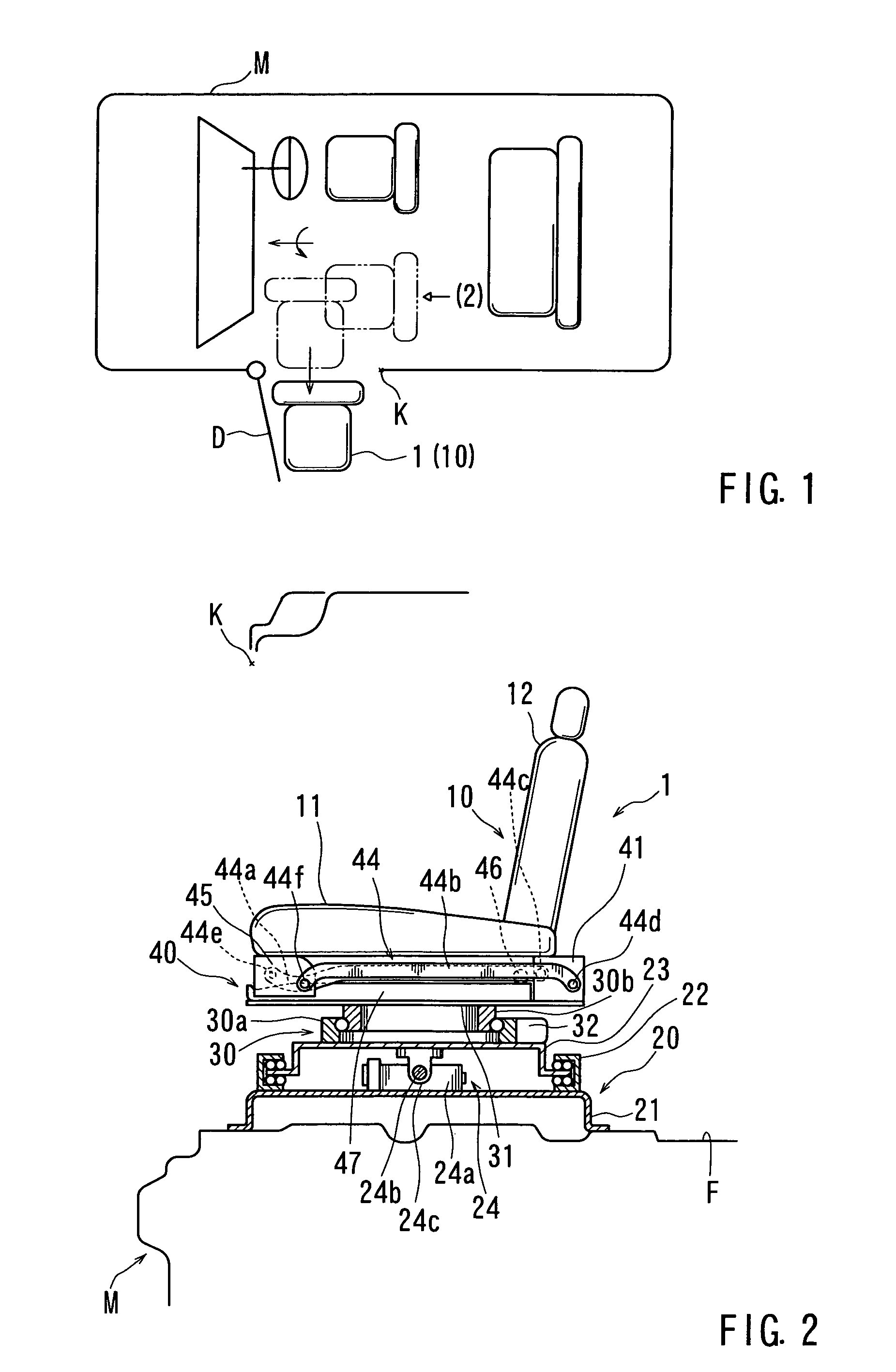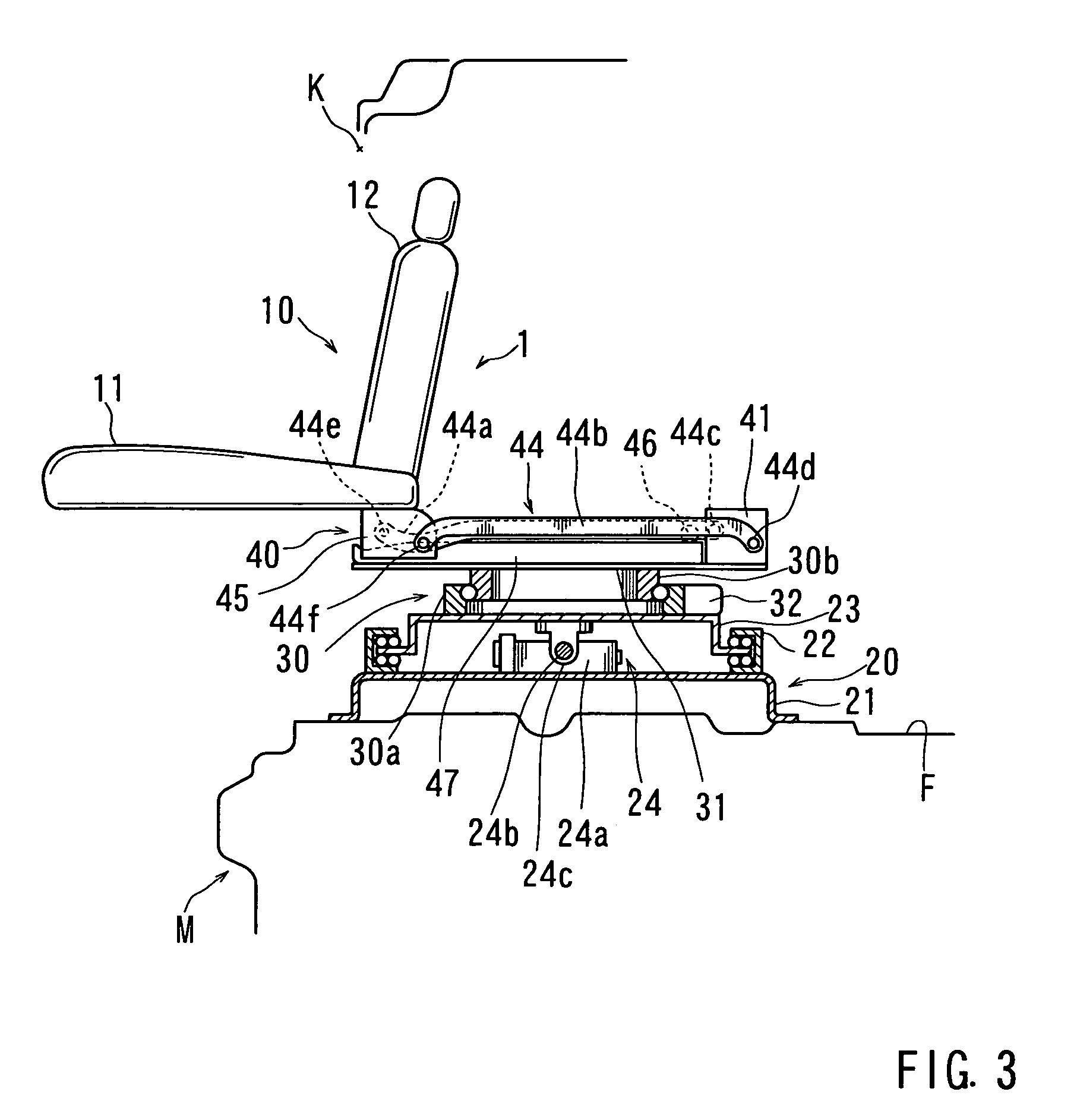Seat moving device for vehicle
a technology for moving devices and seats, applied in the direction of movable seats, roofs, transportation and packaging, etc., can solve the problems of premature deterioration of electric motors, and achieve the effect of preventing damage to the driving devi
- Summary
- Abstract
- Description
- Claims
- Application Information
AI Technical Summary
Benefits of technology
Problems solved by technology
Method used
Image
Examples
second embodiment
[0087]Consequently, the second embodiment is provided in order to reduce the raising force acting on the widthwise slide base 41 when the widthwise slide base 41 moves.
[0088]FIG. 12 is a side view of the raising / lowering mechanism 48 for the seat main body 10. FIG. 13 is a rear view of the same. Further, in FIG. 12, the lower link arm 44b, which is not directly pertinent, is omitted, and mainly the upper link arm 44a is shown. As shown in the drawings, in the second embodiment, an auxiliary roller 61 is provided as a horizontal retaining member which directly supports the lower surface of the upper link arm 44a and guides the upper link arm 44a so as to horizontally move the same. The auxiliary roller 61 is attached to the side surface of the cam plate 47 so as to be rotatable at a fixed position. The auxiliary roller 61 is positioned near the boundary between the horizontal guide surface 47a and the inclined guide surface 47b.
[0089]That is, in the second embodiment when the widthw...
third embodiment
[0096]Consequently, the third embodiment is provided in order to prevent broad transmission of the impact that is generated due to prevention of the overrun of the seat main body 10 when the seat main body 10 moves to a lowered position.
[0097]In the third embodiment, a driving device 70 for widthwise sliding, which moves the widthwise slide base 41 (which is not shown in FIGS. 14-16), is equipped with an overrun preventing means. As shown in FIG. 14, the driving device 70 for widthwise sliding is composed of an electric motor 71 as a drive source, a screw shaft 73 rotated by the electric motor 71 via a reduction gear 72, and a movable nut 74 meshing with the screw shaft 73 or other such components. For example, the electric motor 71, the reduction gear 72, and the screw shaft 73, are attached to the side of the widthwise slide base 41, and the movable nut 74 is attached to the rotation base 31 side. The screw shaft 73 is equipped with a stationary nut 75 which serves as a means for ...
first embodiment
[0098]As described with regard to the first embodiment, the stopping of the seat main body 10 at the lowered position, i.e., the stopping of the widthwise slide base 41 at the advance position, is performed by a pulse signal from a limit switch (not shown) or the electric motor 71. However, if there is any abnormality in these components, an overrun occurs.
[0099]FIG. 15 shows a normal stopping condition in which the seat main body 10 is stopped at a predetermined lowered position. In this condition, the movable nut 74 and the stationary nut 75 are opposed to each other with a predetermined interval C therebetween. FIG. 16 shows an overrun condition in which the seat main body 10 is excessively moved over the predetermined lowered position. In this condition, the movable nut 74 and the stationary nut 75 abut each other, thereby limiting the movement of the seat main body 10.
[0100]In this way according to the third embodiment, at the time of overrun the stationary nut 75 fixed to the ...
PUM
 Login to View More
Login to View More Abstract
Description
Claims
Application Information
 Login to View More
Login to View More - R&D
- Intellectual Property
- Life Sciences
- Materials
- Tech Scout
- Unparalleled Data Quality
- Higher Quality Content
- 60% Fewer Hallucinations
Browse by: Latest US Patents, China's latest patents, Technical Efficacy Thesaurus, Application Domain, Technology Topic, Popular Technical Reports.
© 2025 PatSnap. All rights reserved.Legal|Privacy policy|Modern Slavery Act Transparency Statement|Sitemap|About US| Contact US: help@patsnap.com



